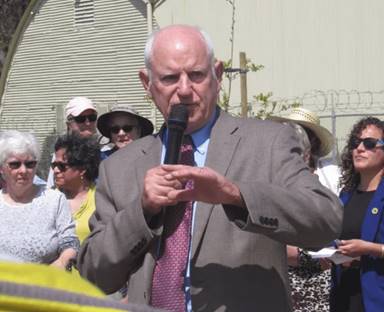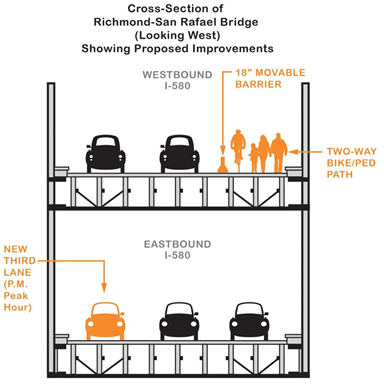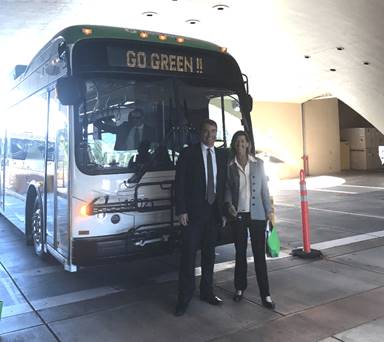|
| Marin County has far more jobs than homes, especially affordable homes. When the Bay Area economy turned red-hot in the last five years, one result was that employees working in Marin but living in the more affordable East Bay caused traffic across the Richmond-San Rafael Bridge to increase dramatically during the morning and evening commute hours.
The evening congestion westbound was so bad that traffic was backing up to Highway 101, slowing the commute of Marin and Sonoma County commuters. Inconveniencing North Bay commuters, of course, could not stand, and legislators pulled out al the stops for a solution.
The result was a grand bargain among Caltrans, Chevron, MTC, BATA, bicycle advocates and legislators at several levels on both sides of the Bay.
- A third lane eastbound across the bridge would be opened in the afternoon and evening to relieve congestion at the west end of the bridge. This would be a four-year pilot project.
- The Bay Trail spur connecting Point Richmond with Point Molate and providing a safe crossing of I-580 would be constructed. This would replace a deadly and unprotected bike trail along the shoulders of I-580 that was originally built as a CEQA mitigation.
- The third lane westbound on the bridge would become a bike-pedestrian trail, connecting Contra Costa and Marin Counties. It would be separated from vehicle lanes with a movable barrier, similar to that on the Golden Gate Bridge, that could be moved for maintenance or emergencies. This would also be a four-year pilot project.
- The changes would be funded by BATA (Bay Area Toll Authority)
Once the bargain had been struck and the project funded, Marin County legislators started to try and dismantle it (First Step Taken Towards Removing Bike Lane from Richmond-San Rafael Bridge Plan and Richmond-San Rafael Bridge Upper Deck Lane Mulled).
MTC and BATA agreed to study the proposal and came up with some interesting findings:
- The bridge, which was completed in the 1950’s is not engineered to accommodate the additional loads that would be imposed by full vehicle use of a third westbound lane. Modifications could be expensive.
- Adding signage, like that in the eastbound direction, would be expensive. It could not be attached to the existing structure as in the eastbound lanes.
- Moving the barrier daily to accommodate commute traffic would be very expensive.
- Programmatic changes and structural changes to the east approach, such as removing the toll booths, increasing use of carpools and public transportation, designating express lanes and congestion pricing could almost eliminate the westbound commute congestion. What they found is that the early morning westbound backup can be eliminated without opening a 3rd lane to traffic with just a 10% reduction in vehicle travel demand, equivalent to taking 400 cars off the bridge. One way this could be done is by moving 200 people into 4 buses, 150 more HOV2+ carpools and 50 cyclists.
As CCTA chair last year, I was also able to get $210 million into RM3 to pay for congestion reduction improvements at both ends of the Richmond-San Rafael bridge, including $75 million for east approach improvements.
Adding a third westbound lane is not as simple as it sounds. Currently, there are two westbound lanes on I-580 west of the bridge and one westbound lane on Sir Francis Drake – for a total of three. The problem is that 2/3 of the westbound traffic takes Sir Francis Drake. Opening up the third lane would simply move the congestion from the east end of the bridge to Marin County.
While the third eastbound lane has cleared up congestion in Marin in the evening, it has exacerbated congestion on the Richmond parkway, as 50% more vehicles, many of them heading north on I-80, cram onto the two-lane Richmond parkway.
At our last meeting on this subject at MTC, Marin County representatives agreed to continue working on solutions other than the third westbound lane. Then they proceeded to break that agreement and lobby even harder to dismantle the bike lane, scheduled to open in April 2019.

Richmond Mayor Fires Back at Marin’s Attempt to Torpedo Bridge Bike PathIt's called the *Richmond*-San Rafael Bridge, but you wouldn't know it going by the behavior of Marin officials
By Roger Rudick , Jan 28, 2019

Richmond Mayor Tom Butt
Note: GJEL Accident Attorneys regularly sponsors coverage on Streetsblog San Francisco and Streetsblog California. Unless noted in the story, GJEL Accident Attorneys is not consulted for the content or editorial direction of the sponsored content.
Richmond Mayor Tom Butt has written a scathing letter protesting the Transportation Authority of Marin’s (TAM) unilateral efforts to prevent cyclists from ever using the Richmond-San Rafael Bridge during rush hour.
From the Mayor’s letter, dated Jan. 28, to Stephanie Moulton-Peters, Chair of the TAM Board of Directors:
am concerned about the action the Transportation Authority of Marin took at its January 24 meeting, regarding the Richmond-San Rafael Bridge, especially the reduction of the pilot period for the multi-use bicycle and pedestrian path from four years to six months
I wish to remind you that the name of the bridge is the Richmond-San Rafael Bridge, since it appears you have ignored the fact that this crossing equally serves Richmond and Contra Costa County as well as Marin. Various options have been openly discussed at more than one stakeholders meeting at MTC to provide congestion relief without eliminating the bicycle and pedestrian path, however TAM is taking unilateral action in bad faith to change the agreed-on intent of the upper deck improvements.
I also can’t help observing that the root cause of the congestion is the failure of Marin County to provide adequate affordable housing for its workforce, thus creating a massive commute from the more affordable East Bay. This is an unsustainable problem that Marin needs to confront.
Until now, this multi-year and multi-million dollar project has been a collaborative regional effort that included community groups and residents on both sides of the bridge. In anticipation of the multi-use bicycle and pedestrian path scheduled to open this spring, Richmond and Contra Costa have been investing in the infrastructure needed to create safe access and connections for bicyclists and pedestrians. Six months is not an adequate amount of time to determine whether the multi-use path should remain open for bicyclists and pedestrians or be converted into another lane for vehicle traffic, as it appears is TAM’s intended outcome.
The two-way bike and pedestrian path is scheduled to open in April. Under the current plan, five lanes of the bridge would be available for private automobiles, with one lane on the upper level reserved for a two-way bike and ped path, as seen below:

Marin officials want to eliminate the planned bike and ped path (above right). Image: MTC
As previously reported, the confessed drunk/hit-and-run driver, Marin Supervisor Damon Connolly, who sits on the governing boards of the Metropolitan Transportation Commission and the Transportation Authority of Marin (TAM), is leading a charge to continue to ban cyclists and pedestrians on the bridge.
Under Connolly’s proposal, cyclists would be permitted on the bridge only during off-peak hours, eliminating e-bikes or regular bikes as a commuting option. As those close to the goings-on explained, Marin has also done nothing to improve bike and pedestrian connections on their side of the bridge, leaving cyclists with no safe way to get to the path on the western approach and setting up the bike-path pilot for failure.
By reducing the pilot from four years to six months, it virtually assures that the bike lane will be lightly used (since there will be no time to realize better western approaches) justifying its conversion back into a lane for cars.
“There are a lot of solutions that have been discussed in detail that can reduce or end congestion at the east end without opening the third lane to traffic. We should be working together on these, but they don’t want to do that,” added Mayor Butt in an email directly to Streetsblog. “At the end of the day, the root cause is a failure of Marin to provide adequate affordable housing for their workforce. Importing workers that require long commutes is simply exacerbating fossil fuel use and global warming.”

Editorial: Is Marin Supervisor Damon Connolly a Closet Climate-Change Denier?
He's all greeny when it's politically easy, but he's leading the charge to sabotage the bike path on the Richmond-San Rafael Bridge
By Roger Rudick
Jan 23, 2019

Marin County Supervisors Damon Connolly and Katie Rice posing in front of an electric bus. Photo from Connolly's Facebook page
Note: Metropolitan Shuttle, a leader in bus shuttle rentals, regularly sponsors coverage on Streetsblog San Francisco and Streetsblog Los Angeles. Unless noted in the story, Metropolitan Shuttle is not consulted for the content or editorial direction of the sponsored content.
Marin Supervisor Damon Connolly, who represents San Rafael, boasts about electric buses, preparing for sea-level rise, and supporting relatively uncontroversial bike paths. But when it comes to having political spine and actually pushing back against motoring interests, he takes a different tack; he’s actively trying to switch the bike and pedestrian path planned for the Richmond-San Rafael bridge into another lane for cars.
Connolly sits on the Metropolitan Transportation Commission, Bay Area Toll Authority and Transportation Authority of Marin (TAM) governing boards. Last year, he led a charge to make the shoulder on the top deck of the Richmond San-Rafael bridge–long slated to become a two-way bicycle and pedestrian path–available as a sixth lane for motor vehicles during peak periods. Keep in mind that now there are three lanes for cars on the lower deck and two on the upper. The shoulder on the upper deck is still there for maintenance and emergency vehicles. In April, the shoulder will be opened to cyclists, so it can double as a bike commuting route.
The lane was to remain that way for four years, pending further evaluation. But now the Transportation Authority of Marin, thanks to a push by Connolly, wants to cut that pilot back to just six months.
Jean Sevinghaus, Marin member at large from the Caltrans District 4 Bicycle Advisory Committee, forwarded Streetsblog a draft letter from Dianne Steinhauser and Dan Cherrier, Deputy Executive Directors of the Transportation Authority of Marin, to be presented to the Board of Commissioners for approval tomorrow, Thursday Jan. 24.
From the letter:
BATA has considered a 4-year pilot as the suitable longevity of a multi-use-pathway-only utilization of the upper deck shoulder area. TAM requests an assessment period of 6 months be considered, commencing with the current planned opening of the multi-use path in April 2019. Studies of the structure and of traffic should be completed within the first six months of pathway operation, followed by a review and evaluation of options for operating the corridor by all the partners.
The record low unemployment in Marin County has Marin County employers stating that problems hiring and retaining employees is of great concern. The need to address the commute of employees coming from the East Bay is growing daily. We are concerned that a relatively small number of users of the multi-use path may adversely affect the ability of Marin workers to meet their employment obligations. Many of our teachers, safety workers such as police and fire, and other workers depend on the Bridge daily to get to work on time. TAM continues in our dedication to making this corridor operate as effectively as possible for all users. Supervisor Damon Connolly, our Metropolitan Transportation Commission/Bay Area Toll Authority Commissioner, and I are available to discuss this further with the BATA leadership and assist in moving these ideas forward.
A six-month trial–or even a four-year trial, if current conditions persist–will clearly show few cyclists using the bridge. That’s because TAM has not built safe connections to the bridge on the Marin side, explained Sevinghaus. “They’re doing a great job on the Richmond side. You can go from the Richmond side to the water side to downtown Berkeley, but on the Marin side there’s these glaring gaps where you have to ride along the freeway,” she added. “It’s still really dicey.”
Marin Supervisor Damon Connolly wants the planned bike and ped path, shown top right, turned into yet another lane for cars during “peak” periods
Sevinghaus said riders will either be too intimidated to use the approaches or there will be a horrible crash that kills or maims a cyclist. Either way, “It all fits a self-fulfilling prophecy, because they aren’t putting muscle behind electric bike-share programs and the infrastructure to connect the bridge. If you don’t do that, you’re going to make it a failure, and then you’re going to say ‘see, it’s a failure,’” said Brett Thurber, co-founder of electric-assist bike maker The New Wheel, which has a shop in Larkspur, near where the bridge touches down in Marin.
Thurber points out that San Rafael would be a half-hour ride by e-bike from the BART station at Richmond. “That makes it competitive with driving.” He added that people come into his shop to price out bikes with the idea of switching from driving across the bridge to a bike-plus-transit option when the bridge is finally opened to bikes. But they can’t make the change without the infrastructure. “Expecting people to invest in a machine to do it with the range and performance to do it, day in and day out, doesn’t work if it’s a four-year pilot only–even less so with a six-month pilot.”
The irony, of course, is that opening up a westbound lane for cars isn’t going to solve traffic delays for motorists either, explained Dave Campbell, advocacy director for Bike East Bay, in a phone call with Streetsblog. The bottleneck going west, he said, is the toll plaza on the Richmond side. “If Damon Connolly can wave a magic wand and get rid of that, guess where that bottleneck will go–straight into his front yard, where the traffic flows into Marin County on 101. That’s all he’s going to achieve.”
Campbell said traffic going west from Richmond splits in two directions: south towards San Francisco and north to the rest of Marin and Sonoma. If Connolly really wants to help with the traffic problem, he should be lobbying hard to massively expand the newly opened Richmond-to-San Francisco ferry, to give East Bay commuters an alternative to the bridge. “Let’s hope the new ferry service will help the people going south to San Francisco. I’d love to know his opinion on that, being the transportation expert he is,” quipped Campbell. Streetsblog also has calls in to the Marin County Bicycle Coalition and will update this post accordingly.
Meanwhile, Tom Butt, the Mayor of Richmond, is away at the National Conference of Mayors; it appears that nobody in Richmond was consulted about the Marin attempt to reduce the pilot to six months. Streetsblog forwarded the letter to Alex Knox, Mayor Butt’s Chief of Staff, who replied that “…it appears to be completely counter to our goals and vision for the upper deck of the bridge.”
Either way, the study Connolly is proposing to accelerate appears to be a fait accompli: since TAM apparently has no intention of making safe connections to the bridge, bike ridership will be low and it will no doubt be opened up to cars. The biggest single emitters of greenhouse gases in Marin County (and the Bay Area) are cars. Adding more traffic to the bridge is only going to increase those emissions. And Connolly appears to be in denial of this simple fact.
The letter is due to be approved by the TAM Board this Thursday, tomorrow, Jan. 24, at 7 p.m., Marin County Civic Center, 3501 Civic Center Drive, Room 330, San Rafael.
If you live in Marin and want to share your thoughts with Connolly, his phone number is 415-473-7354 and his email is dconnolly@marincounty.org |

